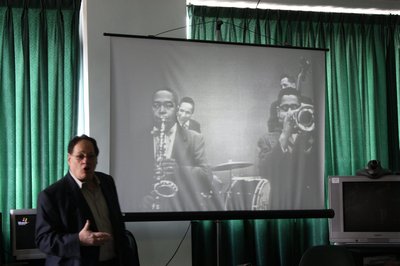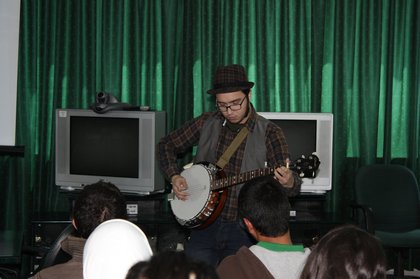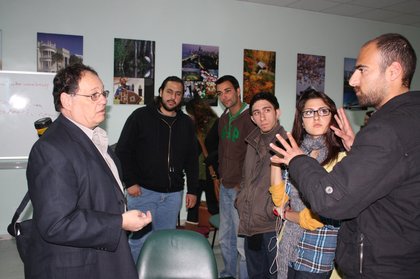I spoke on jazz and blues at the University of Jordan, a modern 45,000-student institution, in an event sponsored by the American Embassy while in Amman on family matters a couple weeks ago. About 50 avid students of music, arts and literature and their informed faculty watched videos of Louis Armstrong at age 32 doing “Dinah,” Charlie Parker & Dizzy Gillespie playing “Hot House,” Billie Holiday with all-stars singing “Fine and Mellow” and Muddy Waters among other immortals from the American Folk Blues Festival, 1962-69, vol. 3. I talked about blues and jazz being one in essence, but different in practice. Then second-year Jordanian student Nabil Gonzalez played banjo, harmonic and sang two original numbers in a U.S. folkie style. “I’m passionately in love with bluegrass music!” Gonzalez told me. Other of the young people were eager for jazz and blues, but said they had little access to the music or information about it.
One composer in attendance, Nabil Benabdeljalil from Morocco, asked if jazz musicians are conscientiously intentional when they improvise or if they just do whatever. I assured him the best players know what they’re doing, though they may also seek to transcend the limits of their preparations. He send me an MP3 of a recent through-composed piece, “Ombre d’une flamme” (“shadow of a flame”) for piano, oud, drums/percussion, perhaps kanun (a zither) and soprano sax. Twelve and a half minutes long, it starts at a stately pace, develops through  polytonality into jazz-like energy and instrumental interaction and sax, and ends by returning to its initial moody mystery. Sadly, I can’t post that piece, but here’s Nabil playing piano on his work “Consolación” for soprano voice, cello and soprano sax, in an irresistible setting:
howardmandel.com
Subscribe by Email |
Subscribe by RSS |
Follow on Twitter
All JBJ posts |



